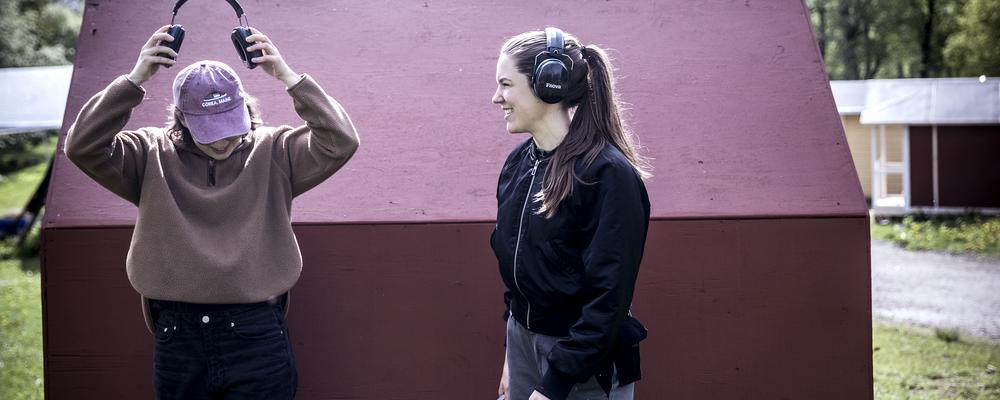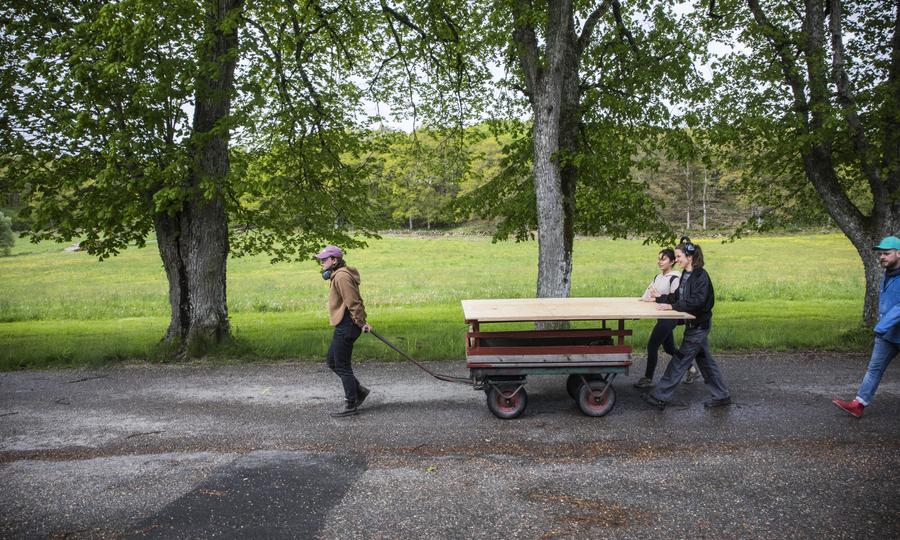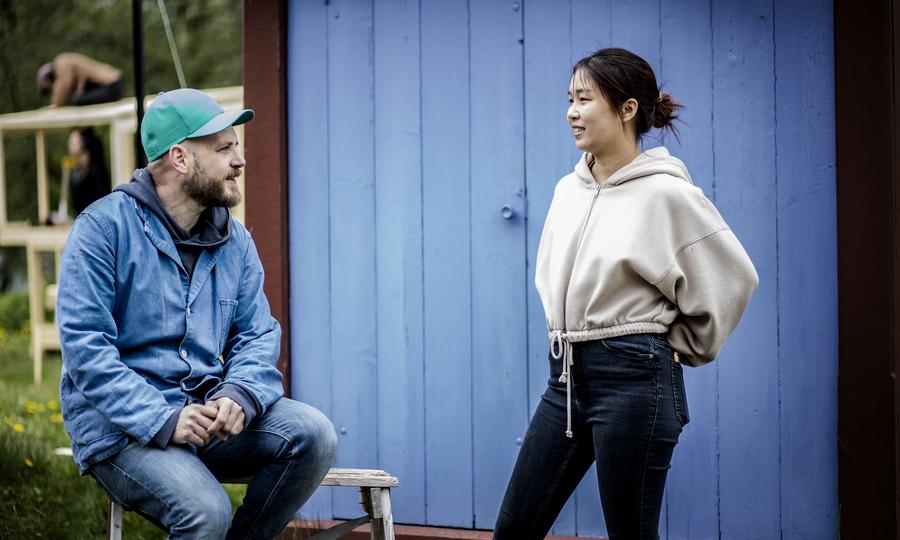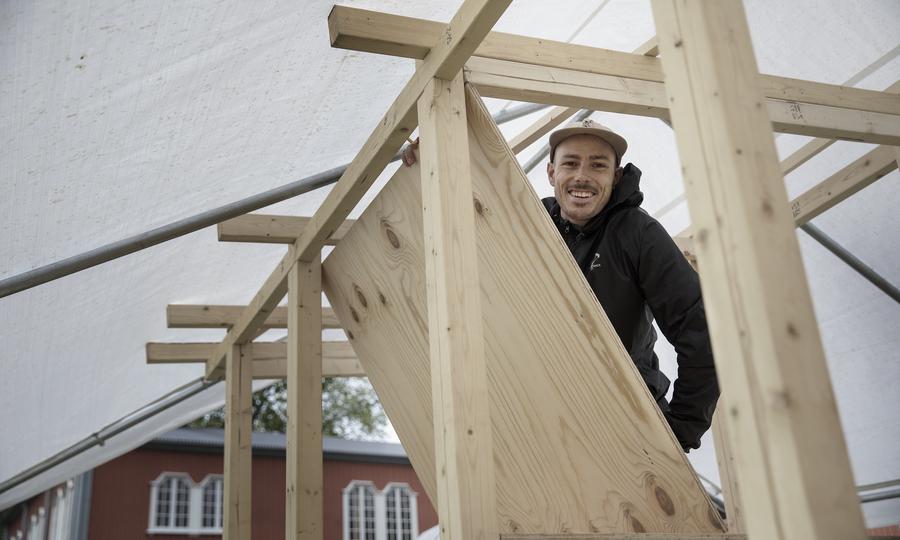
- Home
- News and events
- Find news
- Playhouse 2.0 – New Design Brings Students and Children Together
Playhouse 2.0 – New Design Brings Students and Children Together
A lookout tower and panoramic views instead of white trim and divided-lite windows. At Nääs Konsthantverk, an arts and crafts centre outside of Gothenburg, students in HDK-Valand's master’s programme in Child Culture Design are challenging the traditional image of a playhouse. Design precedents from around the world come together with Swedish children’s experiences of play to create a shared process that explores playhouse possibilities.
Nääs Castle has some new neighbours. Two new houses are being built on the meadow opposite the castle, with views overlooking a little lake, and they are just as magnificent inside as the old castle – at least that’s what kids will tell you. Because these houses have tunnels, ramps, great hiding places and a tower that invites climbing and offers a spectacular view.
Here students from HDK-Valand’s graduate programme in Child Culture Design (CCD) are exploring and experimenting with the design of the playhouse. The course is called Mobility and Play, a collaboration with the Nääs School of Crafts and Building Conservation Centre.

Kids are experts at play.
Basing their work on the site, child development research, participatory design processes and – above all – ideas and reflections from schoolchildren in the surrounding area, CCD students are creating playhouses that put their users on centre stage.
“Playhouses are often created based on what we adults believe and think is good design for kids,” says Leonie Magnusson, one of the HDK-Valand students. “But if you want them to be used, you have to listen to the people these houses are meant for. Kids are experts at play.”
Her hands and arms are covered in blue. On the meadow in front of Nääs Castle, empty paint cans lie on a blue-spotted lawn, twinkling in the sun.
“We’re in the midst of a kind of trial-and-error process right now,” she says. “The kids in the project have helped us paint the house. Actually the idea was for just some parts to be blue, but they went wild and wanted to paint the whole thing blue. So now everything is kind of half blue. We’re trying to move forward based on the new conditions,” says Leonie, laughing.
“So now we need to determine if we should keep on painting blue or maybe choose a completely different colour,” says Qiushi Wang, whose fingers indicate she belongs to the same team as Leonie.

Students come from all over the world
Co-design is a common thread running through the entire course, and the shared process includes more than just local children. Qiushi is from China and Leonie is from Germany. CCD’s students come from all over the world, bringing with them a wide variety of different design experiences. They are divided up into two teams and working together toward the same goal.
Next door to the blue house stands the other group’s playhouse. Hammering can be heard from inside, and a pair of legs can be seen sticking out. These belong to Luke de Jager, who comes from South Africa. Taking a break from working on what will become a tunnel, he says that the opportunity to learn from other students’ experiences was one of the reasons he applied to the programme.
“A democratic process demands a diversity of ideas,” says Luke. “That allows you to explore, find tools to communicate with, and learn to strike a balance between compromising and the limits of your own creative expression.”
When that democratic process also involves children, however, you need a completely different set of tools. One of the CCD instructors, Pontus Johansson, notes that the course includes both theoretical and practical aspects of creating and engaging children in the workshops.
“The challenge is to give everyone a chance to be heard in their own way,” he says, “but also for us to be exposed to thoughts and reflections that aren’t coloured by the expectations of the adult world.”
Participation is a recurring theme throughout this master’s programme, which Johansson says is the only one of its kind. At CCD there is a holistic perspective on children and design that is not common.
“We work with much more than just toys, video games and clothing, which is what a lot of people expect,” he says. “Children are our target group, and we focus on designing for them and with them, from illustrations to urban planning. Always in dialogue with the kids.”

Part of the exhibition Where the Imagination Lives
In the Mobility and Play course, that dialogue has meant a lot of challenges this year. In addition to the language barrier, all of our meetings have had to be held online.
“We resolved that by letting the kids build their own dream playhouses with toothpicks and sticky clay,” says Luke. “Then we based our discussions on their models.”
“In our group,” says Leonie, “we designed ten different playhouse types and let the kids tell us what they liked best – how they and their siblings would want to play with the playhouses.”
These experts’ most frequent comments were broken down into a few clear directives: a good playhouse must have multiple different elevations that are challenging to climb up on, there have to be cubby holes where you can sit by yourself, and the house has to have lots of entrances that don’t clearly indicate how you get in.
Nääs Castle’s new neighbours will soon be ready to go. The playhouses will form part of the exhibition Where the Imagination Lives, which will be on view all summer at the Nääs School of Crafts and Building Conservation Centre.
“It’s going to be fun to see how they’re used,” says Leonie. “We’ll get a definitive indication of whether we’ve done a good job or not.”
Luke agrees.
“At the same time, it’s a little sad that we’ll be finished soon,” he says. After this past winter, it has been fantastic for CCD students to get to be on this beautiful site, to be together again, working with their hands and enjoying the Swedish summer.
Both Leonie and Luke want to continue working in the field of designing for children after they graduate. Leonie plans to work with digital educational tools. Luke is going to return to Cape Town, where he designs things like libraries and playgrounds from a children’s perspective.
Pontus Johansson says that CCD alumni are working with everything from urban planning projects to product design, playgrounds, arts schools and municipalities. Many have jobs leading design processes for children.
“One thing all our students have in common is a passion for letting children’s voices be heard,” he says. “That’s not always the case in our culture. By engaging children in the process, we increase the chances that they grow up understanding they can play an active role in society.”
At the half-blue playhouse, Qiushi and Leonie have come to a decision.
“It’s going to be an all-blue playhouse!”
By: Åsa Rehnström

